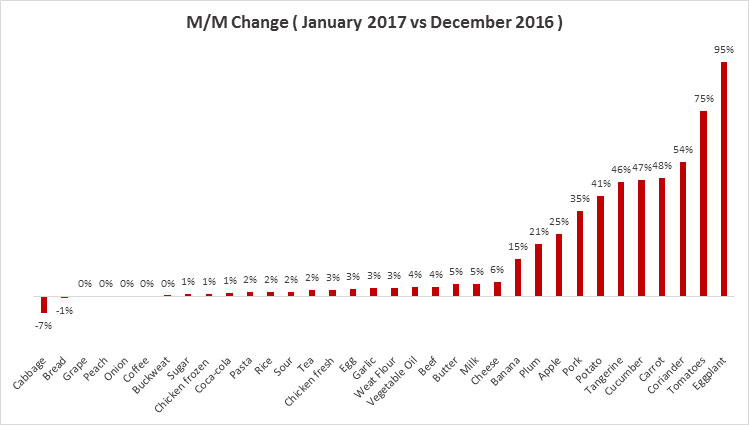Indexes
 19
January
2017
19
January
2017

 19
January
2017
19
January
2017
In the first half of January, Georgian retail food prices went up. Compared to mid-December, ISET’s Retail Food Price index experienced a significant 10.1% increase. Prices increased across key food commodities as a result of the holiday-related slump in demand. The Georgian lari depreciation applied additional upward pressure on the GEL prices of imported food products.
The largest bi-weekly increases were observed for pork (35%), carrots (35%), and tomatoes (34%). At this time of the year, most fruits and vegetables become more expensive. However, it turns out that “borsch” is not a popular dish during the holidays, as prices dropped for cabbage (20%) and onions (4%). Unlike other fruits, the price of bananas, which became more expensive last month (the price of bananas increased by 15% m/m), now decreased by 3%.
Overall, during the last month, only a few food items did not gain in value (see table 1). It is noteworthy that eggplants became 95% more expensive, as the traditional dish of eggplants with ground walnuts is “a must” for the Georgian New Year supra.
Table 1: Percentage changes in prices (m/m)

When looked at from an annual perspective (January 2017 vs. January 2016), on average, retail food prices are 6.2% lower. In this regard, Georgia reflects an overall downward trend in international food prices. For 2016 as a whole, FAO’s Food Price Index went down by 1.5% compared to 2015. On the other hand, the depreciation of the Turkish lira last year might have put additional downward pressure on Georgian food prices (the exchange rate between the Georgian lari and the Turkish lira moved down from 0.80 to 0.70 from January 2016 to January 2017). In addition, Georgian retailers appear to be better equipped to source fresh products from Georgian agricultural producers this year.





